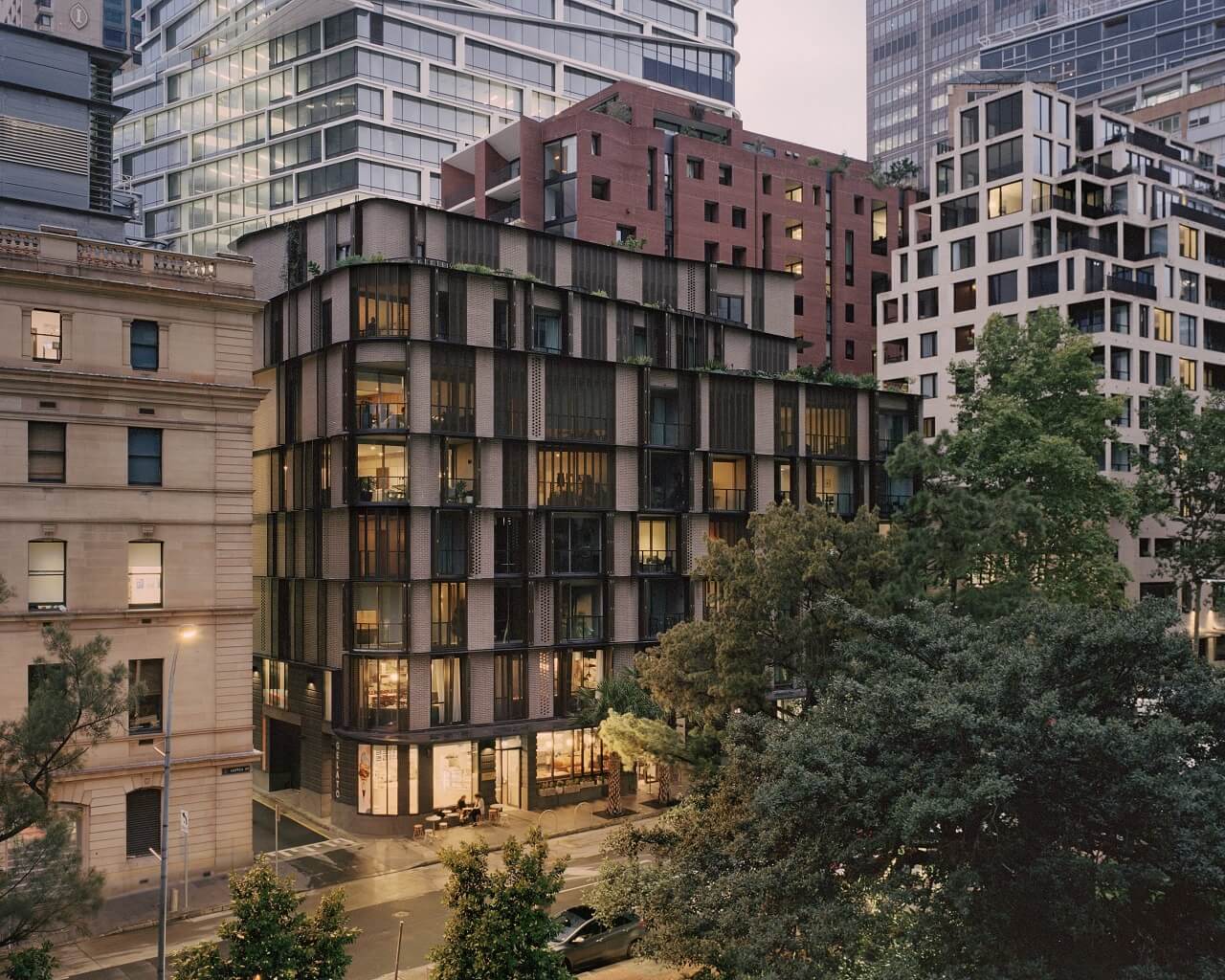The award-winning development changing the way design is done in Sydney
Quay Quarter Lanes won the Walter Burley Griffin Award for Urban Design in last week’s Australian Institute of Architects awards
I t’s 6pm on a weeknight and already, basement bar Apollonia on Young Street is full. Earlier in the day, queues snake along Loftus Lane as customers wait their turn to order lunch at Marrickville Pork Roll. It’s the same story at nearby Hinchcliff House, where it can take weeks to book a table at the busy restaurant.
While Quay Quarter Laneways at Sydney’s Circular Quay has picked up a number of awards, including the Lord Mayor’s Prize for Architecture and the Urban Design Award, it is perhaps the locals who offer the best measure of its success. For architect Shaun Carter, director of CarterWilliamson, it’s a delight to see so many people engaging with this part of the city.
“Before we started working on the laneway, it was scary,” he says.
Made up of five buildings – two existing heritage buildings and three new – Quay Quarter Lanes, tucked in behind the historic Customs House is the result of an eight-year process involving five architectural studios. While Loftus Lane is the main through way for visitors, 9 Young Street by Studio Bright, 15 and 11 Young Street by SJB and 18 Loftus Street by Silvester Fuller are home to several floors of apartments, as well as roof gardens and terraces, balancing privacy with world class views of Circular Quay. Two of the new buildings will also have office, retail and hospitality spaces.
Hinchciff House, one of only two surviving woolstores at Circular Quay, became the focus for the studio of CarterWilliamson while Lippmann Partnership took on Gallipoli Memorial Club.
Engaging five leading (but not large) Sydney architecture studios to collaborate on Quay Quarter Lanes, rather than one firm, is a marked departure from the way redevelopment has been done in Sydney. ASPECT Studios took responsibility for the landscape and urban design for both Quay Quarter Lanes and the adjacent Quay Quarter Tower.
Co-ordinating architect and SJB director Adam Haddow says bringing in five studios to work across the 2,200sqm site allowed for greater attention to be given to even the smallest aspects of each building.
“The best architecture is about smallness and specificity,” Haddow says. “Each building had its own site foreman and architect leading it. When you can form a team of diverse thinkers who can work those issues out between boundaries, you get great results.”
Although the buildings are quite different, the expectation was that they would make room for each other to be their best selves. This required a lot of conversations between architectural practices.
“It was a bit like herding cats,” Haddow admits. “But if you leave a project in one set of hands, no matter how good those hands are, they are spread thinly. If you can get many hands doing small things there is ‘bigness’.”
Carter says the collective met on site on a weekly basis to discuss progress of their work and how it would relate to the other buildings.
“It was like State of Origin where you have all the best players on the one team and they all had to play their part in the retelling of a Sydney block. But it only works if you have great players on the team,” Carter says.
“We met every Thursday and everyone would be tired because of the level of commitment -which was outstanding – but it meant often we weren’t getting enough sleep.”
Drawing on the history of the site, the palette is varied and yet sympathetic, leaning into the texture and warmth of brick for the new buildings and reviving the beauty of the original sandstone for the existing buildings.
In some parts, new brickwork curves upwards, like it has been peeled back from the building. Other parts have arched ceilings finished in finely worked plaster.
“When we started having conversations we had six teams working on how to define ‘place’,” Haddow says. “ASPECT found references to the ‘pleasure grounds’ that they created near Customs House in the early 1800s where people used to come together.”
Wiradjuri/Kamilaroi artist Jonathan Jones was selected to design a number of artworks that have been integrated into the site, from ‘oyster shells’ embedded into mortar lines as a reference to Indigenous middens once found on this site, to ‘fish scales’ using green marble from the demolished lobby of 50 Bridge Street.
“There was a strong narrative of people coming together on the site,” says Haddow.
Tucked in behind the heritage protected Customs House, the development also needed to take site lines to Circular Quay and the harbour into account. Once again, the coordinated collaboration paid dividends.
“All the buildings look down on Customs House,” he says. “Ours was the tallest building at the back so we consolidated the aircon plant so that not every building has to have that ugly service part to it. All the rubbish is also collected in one spot.”
For Haddow, it’s also the rubbish that has been his measure of the success of this project.
“When people really live somewhere, they take care of it and look after it,” he says. “I noticed one evening that there was a guy walking along picking up rubbish and I thought ‘you live here’.”
Lucky guy.
See more stories like this in the first issue of Kanebridge Quarterly magazine here.
This stylish family home combines a classic palette and finishes with a flexible floorplan
Just 55 minutes from Sydney, make this your creative getaway located in the majestic Hawkesbury region.
As Paris makes its final preparations for the Olympic games, its residents are busy with their own—packing their suitcases, confirming their reservations, and getting out of town.
Worried about the hordes of crowds and overall chaos the Olympics could bring, Parisians are fleeing the city in droves and inundating resort cities around the country. Hotels and holiday rentals in some of France’s most popular vacation destinations—from the French Riviera in the south to the beaches of Normandy in the north—say they are expecting massive crowds this year in advance of the Olympics. The games will run from July 26-Aug. 1.
“It’s already a major holiday season for us, and beyond that, we have the Olympics,” says Stéphane Personeni, general manager of the Lily of the Valley hotel in Saint Tropez. “People began booking early this year.”
Personeni’s hotel typically has no issues filling its rooms each summer—by May of each year, the luxury hotel typically finds itself completely booked out for the months of July and August. But this year, the 53-room hotel began filling up for summer reservations in February.
“We told our regular guests that everything—hotels, apartments, villas—are going to be hard to find this summer,” Personeni says. His neighbours around Saint Tropez say they’re similarly booked up.
As of March, the online marketplace Gens de Confiance (“Trusted People”), saw a 50% increase in reservations from Parisians seeking vacation rentals outside the capital during the Olympics.
Already, August is a popular vacation time for the French. With a minimum of five weeks of vacation mandated by law, many decide to take the entire month off, renting out villas in beachside destinations for longer periods.
But beyond the typical August travel, the Olympics are having a real impact, says Bertille Marchal, a spokesperson for Gens de Confiance.
“We’ve seen nearly three times more reservations for the dates of the Olympics than the following two weeks,” Marchal says. “The increase is definitely linked to the Olympic Games.”

Getty Images
According to the site, the most sought-out vacation destinations are Morbihan and Loire-Atlantique, a seaside region in the northwest; le Var, a coastal area within the southeast of France along the Côte d’Azur; and the island of Corsica in the Mediterranean.
Meanwhile, the Olympics haven’t necessarily been a boon to foreign tourism in the country. Many tourists who might have otherwise come to France are avoiding it this year in favour of other European capitals. In Paris, demand for stays at high-end hotels has collapsed, with bookings down 50% in July compared to last year, according to UMIH Prestige, which represents hotels charging at least €800 ($865) a night for rooms.
Earlier this year, high-end restaurants and concierges said the Olympics might even be an opportunity to score a hard-get-seat at the city’s fine dining.
In the Occitanie region in southwest France, the overall number of reservations this summer hasn’t changed much from last year, says Vincent Gare, president of the regional tourism committee there.
“But looking further at the numbers, we do see an increase in the clientele coming from the Paris region,” Gare told Le Figaro, noting that the increase in reservations has fallen directly on the dates of the Olympic games.
Michel Barré, a retiree living in Paris’s Le Marais neighbourhood, is one of those opting for the beach rather than the opening ceremony. In January, he booked a stay in Normandy for two weeks.
“Even though it’s a major European capital, Paris is still a small city—it’s a massive effort to host all of these events,” Barré says. “The Olympics are going to be a mess.”
More than anything, he just wants some calm after an event-filled summer in Paris, which just before the Olympics experienced the drama of a snap election called by Macron.
“It’s been a hectic summer here,” he says.

AFP via Getty Images
Parisians—Barré included—feel that the city, by over-catering to its tourists, is driving out many residents.
Parts of the Seine—usually one of the most popular summertime hangout spots —have been closed off for weeks as the city installs bleachers and Olympics signage. In certain neighbourhoods, residents will need to scan a QR code with police to access their own apartments. And from the Olympics to Sept. 8, Paris is nearly doubling the price of transit tickets from €2.15 to €4 per ride.
The city’s clear willingness to capitalise on its tourists has motivated some residents to do the same. In March, the number of active Airbnb listings in Paris reached an all-time high as hosts rushed to list their apartments. Listings grew 40% from the same time last year, according to the company.
With their regular clients taking off, Parisian restaurants and merchants are complaining that business is down.
“Are there any Parisians left in Paris?” Alaine Fontaine, president of the restaurant industry association, told the radio station Franceinfo on Sunday. “For the last three weeks, there haven’t been any here.”
Still, for all the talk of those leaving, there are plenty who have decided to stick around.
Jay Swanson, an American expat and YouTuber, can’t imagine leaving during the Olympics—he secured his tickets to see ping pong and volleyball last year. He’s also less concerned about the crowds and road closures than others, having just put together a series of videos explaining how to navigate Paris during the games.
“It’s been 100 years since the Games came to Paris; when else will we get a chance to host the world like this?” Swanson says. “So many Parisians are leaving and tourism is down, so not only will it be quiet but the only people left will be here for a party.”
This stylish family home combines a classic palette and finishes with a flexible floorplan
Just 55 minutes from Sydney, make this your creative getaway located in the majestic Hawkesbury region.


















